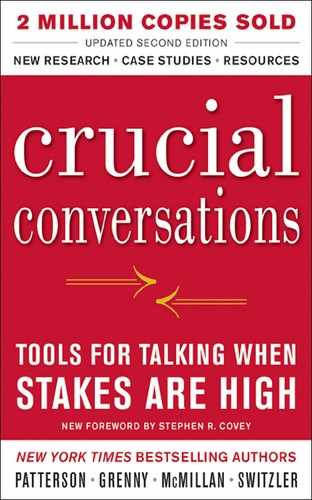SECOND, REFUSE THE FOOL’S CHOICE
Now, let’s add one more tool that helps us focus on what we really want. We’ll start with a story.
The faculty of Beaumont High School is hashing out possible curriculum changes in an after-school meeting that’s been going on for hours. It’s finally the science department’s turn to present.
Royce, a chemistry teacher who’s been at Beaumont for thirty-three years, considers himself the elder statesman of the school. He’s much fonder of war stories than he is of neutrons and electrons, but the administration kind of turns a blind eye because the guy’s a fixture.
At the principal’s cue, Royce clears his throat and begins to yammer on incoherently about the similarities between curriculum development and battle preparations. His antics are so embarrassing that the audience quietly heaves their shoulders as they futilely try to stifle their laughter.
Next, it’s Brent’s, the new guy’s, turn. A couple of weeks ago, the principal asked him to outline the science department’s proposed curriculum changes. Brent met with his colleagues (even Royce), gathered suggestions, and came ready to present.
As Brent begins, Royce starts demonstrating bayonet offensives with a yardstick, and Brent snaps. Slamming his fist on the table, he shouts, “Am I the only one who wonders why we even allow this fossil to talk? Did he miss a pill or something?”
A room full of stunned faces turns toward Brent. Realizing that his colleagues must think he’s possessed, Brent utters those words we’ve all come to hate, “Hey, don’t look at me like that! I’m the only one around who has the guts to speak the truth.”
What a tactic. Brent slams Royce in public, and then instead of apologizing or maybe simply fading into the shadows, he argues that what he just did was somehow noble.
As we saw in the previous chapter with Kevin’s colleagues—under the influence of adrenaline we start to see our options as unnecessarily limited. We assume we have to choose between getting results and keeping a relationship. In our dumbed-down condition, we don’t even consider the option of achieving both.
That’s why those who are skilled at crucial conversations present their brain with a more complex question. They routinely ask: “What do I want for myself, the other person, and the relationship?”
As you practice presenting this question to yourself at emotional times, you’ll discover that at first you resist it. When our brain isn’t functioning well, we resist complexity. We adore the ease of simply choosing between attacking or hiding—and the fact that we think it makes us look good. “I’m sorry, but I just had to destroy the guy’s self-image if I was going to keep my integrity. It wasn’t pretty, but it was the right thing to do.”
Fortunately, when you refuse the Fool’s Choice—when you require your brain to solve the more complex problem—more often than not, it does just that. You’ll find there is a way to share your concerns, listen sincerely to those of others, and build the relationship—all at the same time. And the results can be life changing.
Search for the Elusive And
The best at dialogue refuse Fool’s Choices by setting up new choices. They present themselves with tougher questions—questions that turn the either/or choice into a search for the all-important and ever-elusive and. (It is an endangered species, you know.) Here’s how this works.
First, clarify what you really want. You’ve got a head start if you’ve already Started with Heart. If you know what you want for yourself, for others, and for the relationship, then you’re in position to break out of the Fool’s Choice.
“What I want is for my husband to be more reliable. I’m tired of being let down by him when he makes commitments that I depend on.”
Second, clarify what you really don’t want. This is the key to framing the and question. Think of what you are afraid will happen to you if you back away from your current strategy of trying to win or stay safe. What bad thing will happen if you stop pushing so hard? Or if you don’t try to escape? What horrible outcome makes game playing an attractive and sensible option?
“What I don’t want is to have a useless and heated conversation that creates bad feelings and doesn’t lead to change.”
Third, present your brain with a more complex problem. Finally, combine the two into an and question that forces you to search for more creative and productive options than silence and violence.
“How can I have a candid conversation with my husband about being more dependable and avoid creating bad feelings or wasting our time?”
It’s interesting to watch what happens when people are presented with and questions after being stuck with Fool’s Choices. Their faces become reflective, their eyes open wider, and they begin to think. With surprising regularity, when people are asked: “Is it possible that there’s a way to accomplish both?” they acknowledge that there very well may be.
Is there a way to tell your peer your real concerns and not insult or offend him?
Is there a way to talk to your neighbors about their annoying behavior and not come across as self-righteous or demanding?
Is there a way to talk with your loved one about how you’re spending money and not get into an argument?
